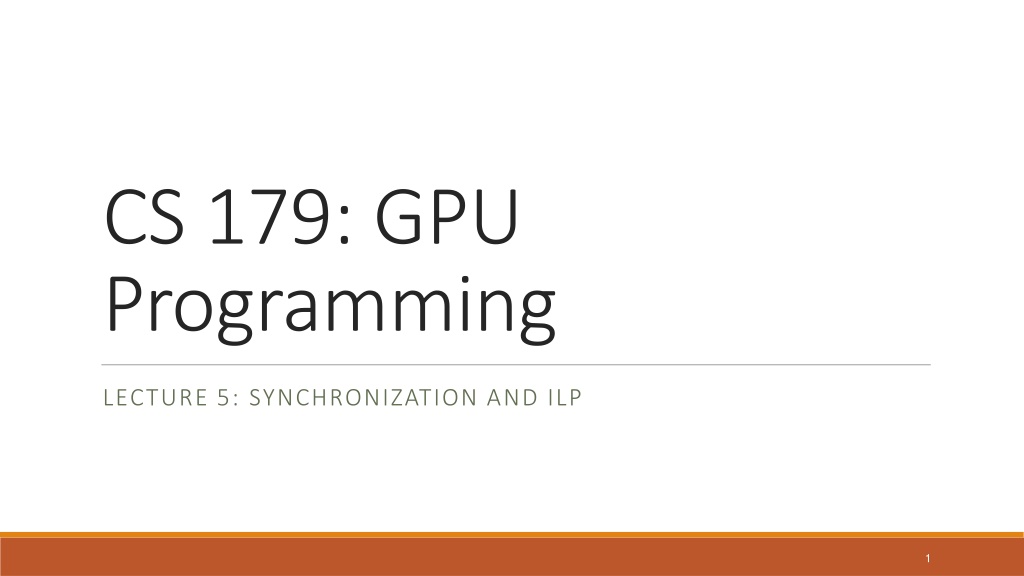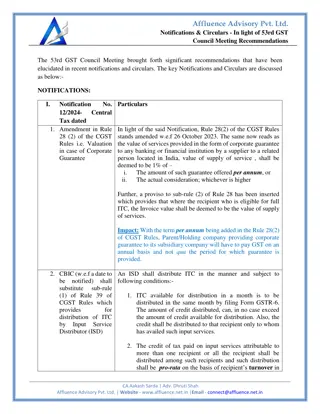
GPU Programming Lecture 5: Synchronization and ILP
Explore synchronization, deadlock prevention, and parallelism in GPU programming. Learn about shared resources, communication between threads, and the importance of synchronization to avoid clashes in multi-threaded environments.
Download Presentation

Please find below an Image/Link to download the presentation.
The content on the website is provided AS IS for your information and personal use only. It may not be sold, licensed, or shared on other websites without obtaining consent from the author. If you encounter any issues during the download, it is possible that the publisher has removed the file from their server.
You are allowed to download the files provided on this website for personal or commercial use, subject to the condition that they are used lawfully. All files are the property of their respective owners.
The content on the website is provided AS IS for your information and personal use only. It may not be sold, licensed, or shared on other websites without obtaining consent from the author.
E N D
Presentation Transcript
CS 179: GPU Programming LECTURE 5: SYNCHRONIZATION AND ILP 1
Announcement Reminder: Instead of emailing us the solution as some assignments may still ask for, please put a zip file in your home directory on Titan, in the format: lab[N]_2021_submission.zip Your submission should be a single archive file (.zip) with your README file and all code. 2
Last time... o GPU Memory System o Global Memory: the slowest and largest form of memory on the GPU, shared by all grids o Coalesced memory access minimizes the number of cache lines read o Shared Memory: very fast memory, located on the SM and shared by the block o Setup as 32 banks that can be accessed in parallel. Each successive 32-bit words are assigned to successive banks o A bank conflict occurs when 2 threads in a warp access different elements in the same bank o Registers: fasted memory possible, located on the SM, scope is the thread o Local Memory: located on the Global Memory, scope is the thread o L1/L2/L3 Cache o Texture and Constant Cache 3
This time: Synchronization and Deadlock -- Digression on Floating Point calculations -- Digression on seeing Compiler optimizations (https://godbolt.org/) Atomic Operations Instruction Dependencies Instruction Level Parallelism (ILP) Warp Scheduler Occupancy 4
Synchronization Ideal case for parallelism: no resources shared between threads no communication needed between threads However, many algorithms that require shared resources can still be accelerated by massive parallelism of the GPU. Need to avoid Deadlock! Processes can depend on each other and get stuck! Each member of a group can wait for another member, including itself, to take action. https://en.wikipedia.org/wiki/Deadlock 5
Synchronization Synchronization is a process by which multiple threads must indirectly communicate with each other in order to make sure they do not clash with each other Example of synchronization issue: int x = 1; Thread 1: x += 1; Thread 2: x += 1; Thread 1 reads in the value of x (which is 1) into a register Thread 2 reads in the value of x (which is still 1) into a register Both threads increment the values they read in but they both think the final value is 2 They write x back out and the final result is 2 6
Synchronization Examples needing synchronization: Parallel BFS (Breadth First Search) see https://en.wikipedia.org/wiki/Parallel_breadth-first_search (assuming thread touches elements in shared memory that were loaded by other threads. Can t start processing until all threads have finished loading data into shared memory.) Accurately summing a list of floating point numbers in parallel Many issues! See http://ic.ese.upenn.edu/pdf/parallel_fpaccum_tc2016.pdf Loading parallel data into a GPU s shared memory Dining philosophers problem https://en.wikipedia.org/wiki/Dining_philosophers_problem 7
Digression: Accuracy Issues for Floating Point Calculations Finite precision arithmetic! (Use double precision for numerical accuracy. Slower.) Addition is NOT associative, so For instance, there is a small enough positive number, such that 1 + = 1 . Consider ( + ) 1 which is equal to (1) 1 which is zero. Re-associate, and compare to + ( 1) which is + ( ) which is . The two different results are very different! Not enough bits to retain full accuracy! Don t add large list of finite precision numbers in uncontrolled order. May as well be a random number generator! Add from smallest to largest, to preserve bits. Earliest C compilers assumed addition was associative, and ruined the calculations. Couldn t easily be used for numeric calculations! 8
Digression on code from compilers See https://godbolt.org/ for useful site to see result from different compilers Sample source code is on the left Resulting compiled code is on the right, where you can choose which compiler you re going to examine. 10
Synchronization On a CPU, you can solve synchronization issues using Locks, Semaphores, Condition Variables, etc. Locks -- https://en.wikipedia.org/wiki/Computer_lock Semaphores -- https://en.wikipedia.org/wiki/Semaphore_(programming) Condition Variables -- https://en.wikipedia.org/wiki/Monitor_(synchronization)#Condition_variables_2 On a GPU, these solutions can frequently introduce too much memory and process overhead Simpler solutions available, many times better suited for parallel programs 11
CUDA Synchronization Usually use the __syncthreads() function to sync threads within a block Only works at the block level SMs are separate from each other so can't do better than this Similar to barrier() function in C/C++ https://en.wikipedia.org/wiki/Barrier_(computer_science) This __synchthreads() call is very useful for kernels using shared memory. 12
Atomic Operations Atomic Operations are operations that ONLY happen in sequence, independent of other processes For example, if you want to add up N numbers by adding the numbers to a variable that starts in 0, you must add one number at a time Don't do this though. We'll talk about better ways to do this in the next lecture. Only use when you have no other options Atomic operations in concurrent programming are program operations that run completely independently of any other processes. See https://www.techopedia.com/definition/3466/atomic-operation 13
Atomic Operations CUDA provides built in atomic operations Use the functions: atomic<op>(float *address, float val); Replace <op> with one of: Add, Sub, Exch, Min, Max, Inc, Dec, And, Or, Xor e.g. atomicAdd(float *address, float val) for atomic addition These functions are all implemented using a function called atomicCAS(int *address, int compare, int val) CAS stands for compare and swap. The function compares *address to compare and swaps the value to val if the values are different Double precision more accurate, but can be much slower! 14
Instruction Dependencies An Instruction Dependency is a requirement relationship between instructions that force a sequential execution In the example on the right, each summation call must happen in sequence because the value of acc depends on the previous summation as well Can be caused by direct dependencies or requirements set by the execution order of code I.e. You can't start an instruction until all previous operations have been completed in a single thread acc += x[0]; acc += x[1]; acc += x[2]; acc += x[3]; ... 15
Instruction Level Parallelism (ILP) Instruction Level Parallelism is when you avoid performances losses caused by instruction dependencies Idea: we do not have to wait until instruction n has finished to start instruction n + 1 In CUDA, also removes performances losses caused by how certain operations are handled by the hardware 16
ILP Example x0 = x[0]; y0 = y[0]; z0 = x0 + y0; z0 = x[0] + y[0]; z1 = x[1] + y[1]; x1 = x[1]; y1 = y[1]; z1 = x1 + y1; COMPILATION The second half of the code can't start execution until the first half completes 17
ILP Example x0 = x[0]; y0 = y[0]; x1 = x[1]; y1 = y[1]; z0 = x0 + y0; z1 = x1 + y1; z0 = x[0] + y[0]; z1 = x[1] + y[1]; COMPILATION Sequential nature of the code due to instruction dependency has been minimized. Additionally, this code minimizes the number of memory transactions required 18
Warp Schedulers Warp schedulers find a warp that is ready to execute its next instruction and available execution cores and then start execution GPU has at least one warp scheduler per SM. Each scheduler has 2 dispatchers. The scheduler picks an eligible warp and executes all threads in the warp . If any of the threads in the executing warp stalls (uncachedmemory read) the scheduler makes it inactive. If there are no eligible warps left then GPU idles Context switch between warps is fast About 1 or 2 cycles (1 nano-second on 1 GHz GPU) The whole thread block has resources allocated on an SM by thecompiler ahead of time GK110: 4 warp schedulers in each SM and 2 dispatchers in each scheduler Can start instructions in up to 4 warps each clock and up to 2 subsequent, independent instructions in each warp. Up to 80 warp instructions to hide latency of warp add (10 cycles) 19
Occupancy Idea: Need enough independent threads per SM to hide latencies o Instruction latencies o Memory access latencies Occupancy: number of concurrent threads per SM o Occupancy = active warps per SM / max warps per SM Number of threads that fit per SM (max warps per SM) is determined by the hardware resources of the GPU. Threads/block matters because (combined with the number of blocks) let s us know how many warps there are on the SM. 20
Occupancy The number of active warps per SM is determined by the limiting resources o Registers per thread o SM registers are partitioned among the threads o Shared memory per thread block oSM shared memory is partitioned among the blocks o Threads per thread block o Threads are allocated at thread block granularity Needed occupancy depends on the code o More independent work per thread -> less occupancy is needed o Memory-bound codes tend to need more occupancy Higher latency than for arithmetic, need more work to hide it Don t need for 100% occupancy for maximum performance 21
GK110 (Kepler) numbers max threads / SM = 2048 (64 warps) max threads / block = 1024 (32 warps) 32 bit registers / SM = 64k max shared memory / SM = 48KB The number of blocks that run concurrently on a SM depends on the resource requirements of the block! 22
GK110 Occupancy 100% occupancy 50% occupancy 2 blocks of 1024 threads 32 registers/thread 24KB of shared memory / block 1 block of 1024 threads 64 registers/thread 48KB of shared memory / block 23
Review of Terms Synchronization Atomic Operations Instruction Dependencies Instruction Level Parallelism (ILP) Warp Scheduler Occupancy 24
Other Resources ILP https://www.nvidia.com/content/GTC-2010/pdfs/2238_GTC2010.pdf Warps and Occupancy http://on-demand.gputechconf.com/gtc- express/2011/presentations/cuda_webinars_WarpsAndOccupancy.pdf 25
Next time... Set 2 Recitation on Friday (04/12) GPU based algorithms (next week) 26






















